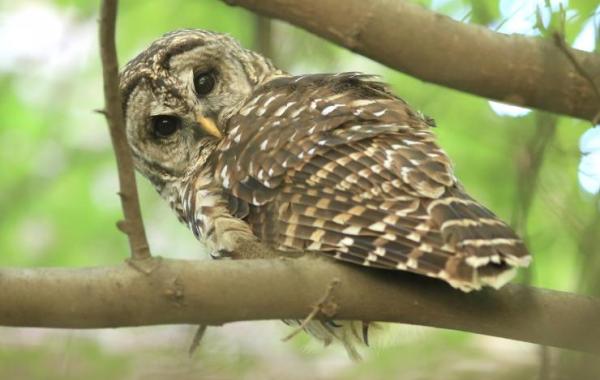Wildlife at Home on Campus

Atlanta is often called the “city in a forest” because of its lush canopy of trees, uncommon for a major city. In the heart of that forest sits Georgia Tech’s 400-acre campus. And within campus lies a variety of wildlife that has made Georgia Tech its home.
“I don’t think most people are aware of wildlife on campus,” said Emily Weigel, senior academic professional in the School of Biological Sciences. “They might see a feral cat here or there, but they don’t really think about all the other animals that live on campus. Georgia Tech is the animals’ home base, and they probably don’t know anything other than they were born in this area. They don’t know they’re in the middle of a city.”
Included in the biodiversity surveys of the area are squirrels, possums, raccoons, rats, and birds. Several months ago a couple of coyotes were spotted, but they were just passing through campus. At least two foxes live in the glade, a densely forested area behind the president’s residence on the north side of campus.
Ben Seleb, a Ph.D. student in quantitative biosciences, is developing an open source camera for studying the foxes and other wildlife. He and his colleagues at Tech4Wildife, a course and campus organization devoted to the conservation of wildlife, have been monitoring the foxes.
“We had some suspicions that foxes were in the glade,” Seleb said. “It’s a very secluded area with dense vegetation, so it’s a great spot for campus wildlife to hide during the day and then come out at night.”
To confirm their suspicions, they set up cameras inside the glade and left them for a couple of weeks. When they reviewed the images, they had captured two foxes on camera at the same time.
“We know there could be more, but we’ve only seen two foxes at one time. They’re difficult to tell apart, but we’re working on identifying individuals,” he said. “There are a number of other animals on campus, and the glade is where many of them live. We have seen raccoons, possums, and a couple of feral cats that travel in and out of the glade.”
The glade connects to Tech’s new EcoCommons, a lush 8-acre woodland area near the center of campus, providing a pathway for wildlife to travel into campus at night, while still giving them the cover of vegetation. Georgia Tech generally offers a handful of classes related to wildlife or ecology, but the amount of wildlife on campus is creating new research opportunities.
“I’m happy to see programs giving students opportunities that they may not have been aware of,” Seleb said.
Birds, Birds, Birds
The lush vegetation on campus provides birds with a source of nutrition as well as a good place to build nests. Horticulturalist Steve Place, who can usually be found working near The Kendeda Building for Innovative Sustainable Design, helps to create a native habitat to support the birds.
“We’re reintroducing native plants to recreate the habitat for the native birds,” Place said. “When you move away from the native landscape it encourages ‘generalist’ birds that are more tolerant of what they can eat. We want to encourage the reemergence of the rarer species of birds that are dependent on particular grasses and berries.”
The campus landscape team is removing ivy and other invasive non-native plants near The Kendeda Building. They’re building a sustainable and regenerative ecosystem that can support itself and the endemic species in the area. Place said that people who visit the area regularly will begin to notice the variety of birds.
“If you’re observant and patient enough you’ll see different behaviors, hear different songs, and observe mating rituals,” he said. “There is a lot going on with the birds. It’s just a matter of being quiet and paying attention.”
The Kendeda Building and the adjacent EcoCommons are part of a wildlife sanctuary certified by the Georgia Audubon Society, making Georgia Tech the first university campus building in Georgia to receive the designation.
Tips for Co-existing With Campus Wildlife
Emily Weigel, senior academic professional in the School of Biological Sciences, provided the following tips.
- In general if you see wildlife on campus keep your distance and just observe. Take in the sights and sounds.
- If possible, record the encounter and post it to iNaturalist, noting when and where the animal was spotted, for Tech’s students and team of scientists studying wildlife.
- Many animals will purposefully avoid you, but if an animal seems to be unafraid or approaches you, do not interact. Keep yourself and any children or pets away.
- Do not feed wildlife. This can cause some animals to stray too far into high traffic areas (in search of food) and potentially get hit by cars. In some cases feeding the animals robs the adults of the ability to teach their young to forage effectively.
- If you find what appears to be “abandoned” young, do not handle them; just monitor them until their parent returns. Most of the time the parent has not really abandoned them, but if you handle the young they may then do so.
- Wildlife rehabbers are legally able to perform any recovery and recouping necessary. Should you find a dead bird on campus, you can help get the information logged for Georgia Audubon’s windows strike data collection by emailing Emily.Weigel@biosci.gatech.edu. If you act quickly, the bird can be recovered for educational purposes through Audubon.
